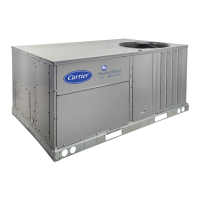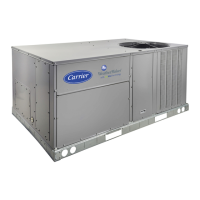Transducer Troubleshooting E On 48/50AJ,AK,
AW, AY units, the electronic control uses 2 suction pressure
transducers to measure the suction pressure of circuits A and B.
The pressure/voltage characteristics of these transducers are in
shown in Tables 101 and 102. On 48/50A2,A3,A4,A5 units,
the electronic control uses 4 pressure transducers to measure
the suction and discharge pressure of circuits A and B. The
pressure/voltage characteristics of these transducers are shown
in Tables 103 and 104. The accuracy of these transducers can
be verified by connecting an accurate pressure gage to the sec-
ond refrigerant port in the suction line.
Table 94 -- Cooling Service Analysis
PROBLEM
COMPRESSOR DOES NOT RUN
Active Alarm
Contactor Open
1. Power off. 1.
2. Fuses blown in field power circuit. 2.
3. No control power. 3.
4. Compressor circuit breaker tripped. 4.
5. Safety device lockout circuit active. 5.
6. High-pressure switch open. 6.
7. Loose electrical connections. 7.
Contactor Closed
1. Compressor leads loose. 1.
2. Motor windings open. 2.
3. Single phasing. 3.
4. ASTP activated (48/50A2,A3,A4,A5 only) 4.
COMPRESSOR STOPS ON HIGH PRESSURE
Outdoor Fan On
1. High-pressure switch faulty. 1.
2. Airflow restricted. 2.
3. Air recirculating. 3.
4. Noncondensables in system. 4.
5. Refrigerant overcharge. 5.
6. Line voltage incorrect. 6.
7. Refrigerant system restrictions. 7.
8. Fan running in reverse direction. 8.
Outdoor Fan Off
1. Fan slips on shaft. 1.
2. Motor not running. 2.
3. Motor overload open. 3.
4. Motor burned out. 4.
COMPRESSOR CYCLES ON LOW PRESSURE
Indoor-Air Fan Running
1. Filter drier plugged. 1.
2. Expansion valve power head defective. 2.
3. Low refrigerant charge. 3.
4. Faulty pressure transducer. 4.
Airflow Restricted
1. Coil iced up.
2. Coil dirty.
3. Air filters dirty.
4. Dampers closed.
Indoor-Air Fan Stopped
1. Electrical connections loose.
2. Fan relay defective.
3. Motor overload open.
4. Motor defective.
5. Fan belt broken or slipping.
SOLUTION
Check active alarms using local display.
Restore power.
After finding cause and correcting, replace with correct size fuse.
Check secondary fuse(s); replace with correct type and size.
Replace transformer if primary windings receiving power.
Check for excessive compressor current draw. Reset breaker;
replace if defective.
Reset lockout circuit at circuit breaker.
Check for refrigerant overcharge, obstruction of outdoor airflow, air
in system or whether compressor discharge valve is fully open. Be
sure outdoor fans are operating correctly.
Tighten all connections.
Check connections.
See compressor service literature.
Check for blown fuse. Check for loose connection at compressor
terminal.
Allow 30 to 120 minutes for cool down. See Compressor Safeties
section on page 39.
Replace switch.
Remove obstruction.
Clear airflow area.
Purge and recharge as required.
Purge as required.
Consult power company.
Check or replace filter drier, expansion valve, etc. Check that
compressor discharge valve is fully open.
Correct wiring.
Tighten fan hub setscrews.
Check power and capacitor.
Check overload rating. Check for fan blade obstruction.
Replace motor.
Replace filter drier.
Replace power head.
Add charge.
Check that pressure transducer is connected and secured to suc-
tion line. If still not functioning, replace transducer.
1. Check refrigerant charge.
2. Clean coil fins.
3. Clean or replace filters.
4. Check damper operation and position.
1. Tighten all connections.
2. Replace relay.
3. Power supply.
4. Replace motor.
5. Replace or tighten belt.
LEGEND
ASTP -- Advanced Scroll Temperature Protection
VFD -- Variable Frequency Drive
78

